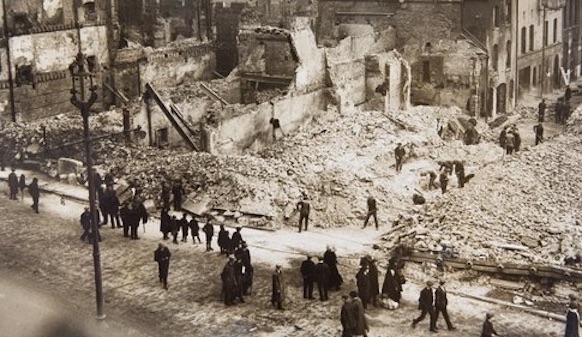
This week marks the 100 year anniversary of the burning of Cork City by British Crown Forces. An account (abridged from an essay by historian Donal Fallon) of the conflict before and the cruelty during the devastating Cork City fire.
“The most colossal single act of vandalism committed in the whole period of the national struggle” was how Florence O’Donoghue, the Head of Intelligence of the Cork No.1 Brigade of the IRA, described the destruction of Cork City on the night of 11 December, 1920.
The Burning of Cork City left the people with not only damages amounting to £3m, in 1920 estimates, but the destruction of many important civic buildings and commercial properties.
A chilling message was sent to Westminister less than a fortnight before by the events that played out at Kilmichael in West Cork, when the Auxiliary Division of the Royal Irish Constabulary suffered a significant military defeat at the hands of the IRA. Seventeen Auxiliaries lay dead on the road. The fear of the IRA’s abilities resulted in the Westminister viewing gallery being closed to the public and barriers being erected on either end of Downing Street.
By December Cork City had been living under a strict nightly curfew. From 10pm each night at least 1,000 troops would leave Victoria Barracks and take over complete control of the City.
What is widely regarded as the catalyst for the destruction of parts of Cork on the night of 11 December, was an ambush by the IRA on two lorries of Auxiliaries within half a mile of the Victoria Barracks, at Dillon’s Cross at 8pm. One Auxiliary was killed and a dozen others were injured.
The IRA who carried out the attack fled, but the reprisal was immediate and inflicted on innocent men who were gathered in O’Sullivan’s public house at Dillon’s Cross. These men were rounded up and subjected to brutal humiliation. One was actually dragged to the centre of the crossroads, stripped naked and repeatedly whipped while being forced to sing ‘God Save The King’ until he eventually collapsed.
The destruction of Cork City began less than two hours after the ambush at Dillon’s Cross.
Alan J. Ellis of the Cork Examiner who was quickly on the scene later recalled that, despite the surprise of the Dillon’s Cross ambush, the reprisal appeared to be highly co-ordinated. Some of the attackers wore scarves over their faces. He came upon Cork Fire Brigade Chief, Fred Huston “valiantly trying to organize his men”. He had seen soldiers pouring cans of petrol into buildings and setting them alight and that the fires were also deliberately started by incendiary bombs.
The worst of the damage was on St. Patrick Street. One historian called Poland noted that most of the south side of Patrick Street was on fire by 11pm. The flames moved further southwards, engulfing buildings on Oliver Plunkett Street (north side), Robert Street, Morgan Street, Cook Street, Winthrop Street, Winthrop Lane, Caroline Street, Maylor Street and Merchant’s Street. He described how “the whole skyline was a shifting orange glow.”
Firefighters were unable to do their jobs, as soldiers stuck their bayonets into the hose pipes.
At 4am the City Hall and adjoining Carnegie Library with its hundreds and thousands of priceless volumes was a sea of flames. As firefighters arrived at the scene with an intact hose soldiers shut off the fire hydrant and refused to let them have access to the water.
By 6am the tower of the City Hall crashed into the blazing ruins below. City Hall was no more. Several firefighters were assaulted and fired upon while trying to do their work. The Chief Officer asked for assistance from Limerick and Dublin. The Dublin contingent accompanied by a large press corps travelled on a specially commissioned train out of Kingsbridge Station. The press and photographers would prove vitally important to ensure that reports and images of the burnt shell of Cork City would reach international audiences.
Two active IRA Volunteers living on Dublin Hill were shot dead in their homes by the Auxiliaries as the city burned. Their story along with other human stories went largely unreported. The images of the scarred buildings however, said all that needed to be said.
Some of the IRA men involved in the Dillon’s Cross ambush lived with the guilty feeling that their actions had directly contributed to the burning of the city and the death of the Delaney brothers. However, the regimental manner in which the burning was carried out suggests pre-meditation and pre-planning.
It’s possible the humiliation suffered by the Auxiliaries at Kilmichael may have motivated the damage on the city. Letters home from the Auxiliaries in the aftermath suggested that it was an act of revenge. One informed his mother “I have never experienced such orgies of murder, arson and looting as I have witnessed in the past sixteen days”.
The commander of the Auxiliary Division would eventually resign in 1921. He felt because they could not catch the guilty few that were on the run, they had been used to murder, rob and loot the innocent.
In an attempt to mock all those who had lost livelihoods and homes in the fire, some Auxiliaries began wearing burnt corks attached to their Glengarry hats. These marked them out as having taken part in the fire.
At the Westminster parliament, Hamar Greenwood, the Chief Secretary for Ireland under David Lloyd George, insisted that the people of Cork had burned down their own city.
![[Irish Republican News]](https://republican-news.org/graphics/title_gifs/rn.gif)
![[Irish Republican News]](https://republican-news.org/graphics/title_gifs/harp.gif)

